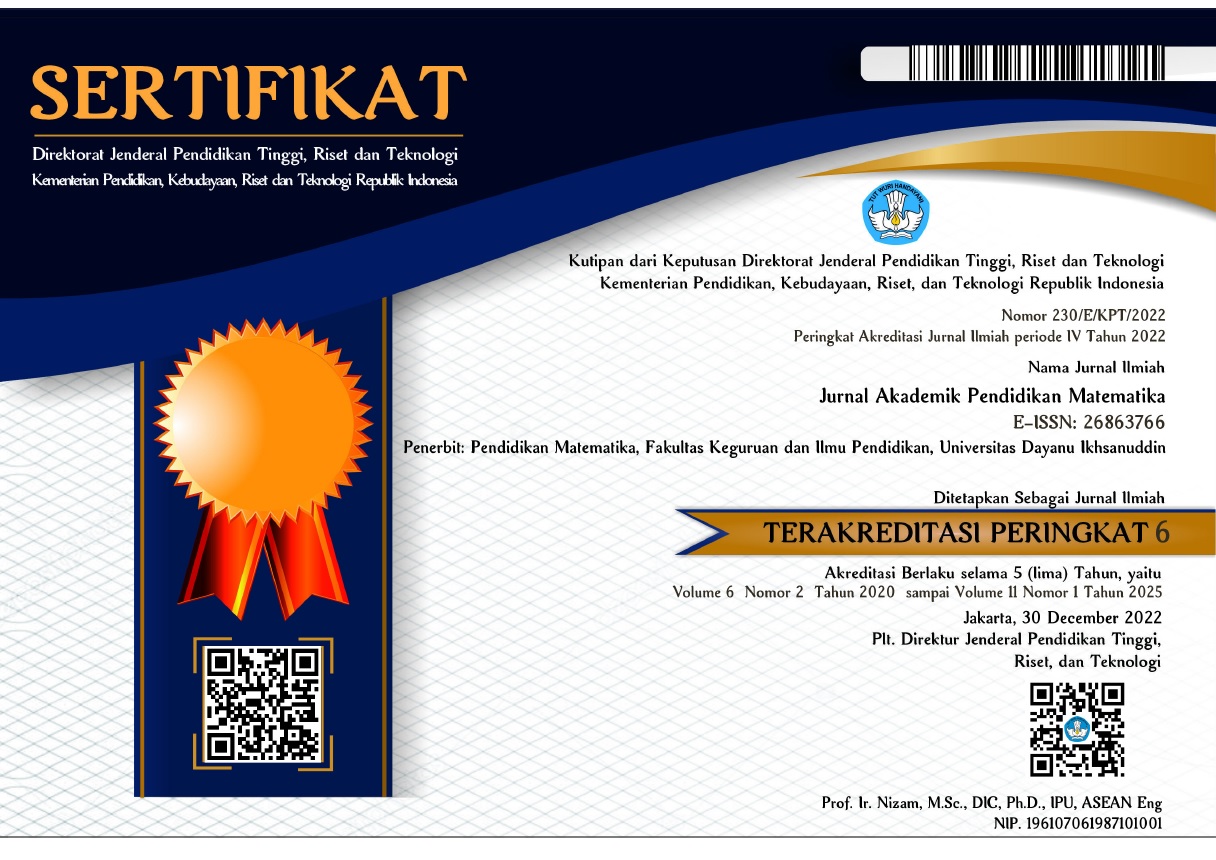Hubungan antara Self-Esteem dan Penalaran Moral dalam Pembelajaran Matematika
DOI:
https://doi.org/10.55340/japm.v9i1.1141Keywords:
self-esteem, moral reasoningAbstract
The formulation of the problem in this study was whether there is a relations self-esteem and moral reasoning in learning mathematics in class VIII students of SMP Negeri 8 Baubau? The pearson of this study was to determine the relationship between sefl-esteem and moral reasoning in learning Mathematics in class VIII students of SMP Negeri 8 Baubau. The type of research is a quantitative study with using the Ex-post Facto method, where the population of this research was all students of class VIII of SMP Negri 8 Baubau wiht a total of 80 students speard over 3 classes. In this study, samples were used was aquestionnaire in learning mathematics. The research data were analyzed by using correlation techniques. From the result of the analysis of correlation techniques, the assessment of self-esteem (X) on moral reasoning inlearning Mathematics (Y) produced a significanse value of 0,000 < 0,05, so it can be concluded that there is a relationsipbetween self-esteem(independent variable) amd moral reasoning in learning Mathematics (dependent variable). The also shows that the two variables have a positive relationship. Thus, the hypothetical decidion that can be taken is that there is arelationship between sef-esteem and moral reasoning ib learning mhatenatics in class VIII Negeri 8 Baubau.
Downloads
References
Anton. M. (2013). Dasar-Dasar Menajemen. Cet.1. Bandung Pustaka Setia
Adriansyah, M. A. (2013). Pengaruh Harga Diri Dan Penalaran Moral Terhadap Perilaku Seksual Remaja Berpacaran. Psikostudia: Jurnal Psikologi, 1-9.
Dolnicar, S. et al. Scholar. (1997). (4). Why We Need the Journal of Interactive Advertising vol. 3 45
Gunarsa & Gunarsa. (1986). Psikologi Perkembangan Anak dan Remaja. Jakarta: PT BPK Gunung Mulia.
Hawadi, R. A. (2004). Akselerasi : A-Z Program Percepatan Belajar Dan Anak Berbakat Intelektual. Jakarta: Grasindo.
Imam Ghazali. (2018). Cara Memperoleh Hidayah Allah. Surabaya CV. Pustaka Media
Jais E, Rezky R, Siombiwi S. (2019). Analisis Faktor-Faktor Penyebab Timbulnya Rasa Takut Siswa akan Kegagalan dalam Mempelajari Matematika. MANDALIKA Mathematics and Educations Journal. 1(2):95.
Mohammad Asikin, I. J. (2013). Kemampuan Komunikasi Matematika Siswa SMP Dalam Setting Pembelajaran Rme (Realistic Mathematics Education). Unnes Journal of Mathematics Education Research 2, 204–213.
Riyadi RN. (2020). Psikologis Klinis Dewasa. (Hardani H. W, ed.). Erlangga.
Rahmatia, Artati Iriana, and Wa Sarido. 2019. “Efektivitas Penggunaan Media Video Tutorial Sebagai Pendukung Pembelajaran Matematika Terhadap Prestasi Belajar Pada Siswa Kelas X SMK Negeri 1 Baubau.” Jurnal Akadenik Pendidikan Matematika 5(2):90–93.
Sardin, S. (2015). “Perbandingan Keefektifan Pembelajaran Guided Inquiry Dan Problem Solving Ditinjau Dari Prestasi Belajar Peluang, Kemampuan Penalaran, Dan Sikap Siswa Terhadap Matematika.” PYTHAGORAS: Jurnal Pendidikan Matematika 10(2):189.
Samosi, A. (1992). Seni berfikir kreatif. Jakarta: Erlannga.
Sudjana. (2002). Metode statistika. Bandung: Tarsito.
Supranto, M.A. (2009). Statistik Teori dan Aplikasi. Jakarta: Penerbit Erlangga.
Wardani, E. P. & Yunarti, T. (2015). Meningkatkan Self-Esteem dan Prestasi Belajar Matematika Siswa melalui Pembelajaran Berbasis Masalah. Matematika dan Pendidikan Matematika 511–516
Yuniarrahmah E, Rachmah DN. (2016). Pola Asuh Dan Penalaran Moral Pada Remaja Yang Sekolah Di Madrasah Dan Sekolah Umum Di Banjarmasin. Jurnal Ecopsy, 1(2), 43-50.



























